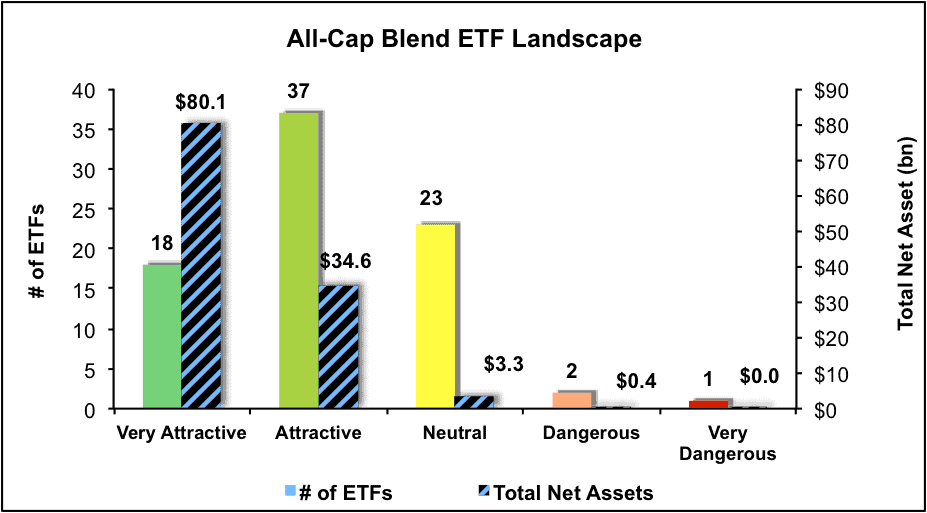The All Cap Blend style ranks second out of the twelve fund styles as detailed in our 4Q16 Style Ratings for ETFs and Mutual Funds report. Last quarter, the All Cap Blend style ranked third. It gets our Attractive rating, which is based on an aggregation of ratings of 81 ETFs and 707 mutual funds in the All Cap Blend style as of October 25, 2016. See a recap of our 3Q16 Style Ratings here.
Figures 1 and 2 show the five best and worst rated ETFs and mutual funds in the style. Not all, All Cap Blend style ETFs and mutual funds are created the same. The number of holdings varies widely (from 4 to 3,747). This variation creates drastically different investment implications and, therefore, ratings.
Investors seeking exposure to the All Cap Blend style should buy one of the Attractive-or-better rated ETFs or mutual funds from Figures 1 and 2.
Figure 1: ETFs with the Best & Worst Ratings – Top 5

Sources: New Constructs, LLC and company filings
Five ETFs are excluded from Figure 1 because their total net assets (TNA) are below $100 million and do not meet our liquidity minimums. See our ETF screener for more details.
Figure 2: Mutual Funds with the Best & Worst Ratings – Top 5

Sources: New Constructs, LLC and company filings
Jensen Quality Value Funds (JNVIX, JNVSX) is excluded from Figure 2 because its total net assets (TNA) are below $100 million and do not meet our liquidity minimums.
PowerShares S&P 500 Quality Portfolio (SPHQ) is the top-rated All Cap Blend ETF and Smead Value Fund (SVFYX) is the top-rated All Cap Blend mutual fund. Both earn a Very Attractive rating.
ProShares Ultra Telecommunications (LTL) is the worst rated All Cap Blend ETF and ProFunds Mobile Telecommunications (WCPSX) is the worst rated All Cap Blend mutual fund. Both earn a Very Dangerous rating.
Harley-Davidson, Inc. (HOG: $55/share) is one of our favorite stocks held by TTFS and earns a Very Attractive rating. HOG was a featured Long Idea in April 2015 and is on October’s Exec Comp Aligned With ROIC Model Portfolio. Since 2009, HOG has grown after-tax profit (NOPAT) by 13% compounded annually. The company has improved its return on invested capital (ROIC) from 13% in 2009 to a top-quintile 21% over the last twelve months (TTM). Despite the improving fundamentals, HOG remains undervalued. At its current price of $55/share, HOG has a price-to-economic book value (PEBV) ratio of 1.1. This ratio means the market expects HOG’s NOPAT to increase by only 10% over the remainder of its corporate life. If HOG can grow NOPAT by 2% compounded annually over the next decade, the stock is worth $63/share today – a 17% upside.
Telephone & Data Systems Inc. (TDS: $27/share) is one of our least favorite stocks held by WCPSX and earns a Dangerous rating. Over the past decade, TDS’ NOPAT has declined by 2% compounded annually to $218 million in 2015, and to $131 million TTM. The company’s ROIC has deteriorated from 6% in 2006 to a bottom-quintile 1% TTM, and TDS has burned through cumulative $934 million in free cash flow over the past five years. Despite the deteriorating operations, TDS remains overvalued. To justify its current price of $27/share TDS must grow NOPAT by 9% compounded annually for the next 11 years. This expectation seems overly optimistic given TDS’ NOPAT has declined over the past decade.
Figures 3 and 4 show the rating landscape of all, All Cap Blend ETFs and mutual funds.
Figure 3: Separating the Best ETFs From the Worst Funds

Figure 4: Separating the Best Mutual Funds From the Worst Funds

This article originally published here on October 26, 2016.
Disclosure: David Trainer, Kyle Guske and Kyle Martone receive no compensation to write about any specific stock, style, or theme.